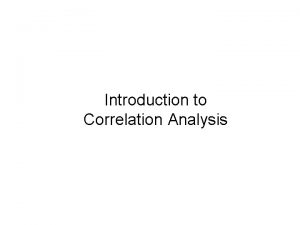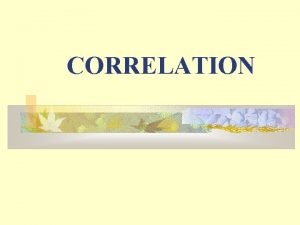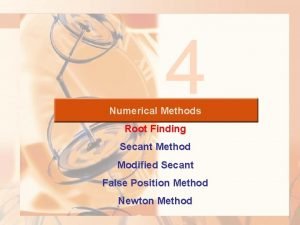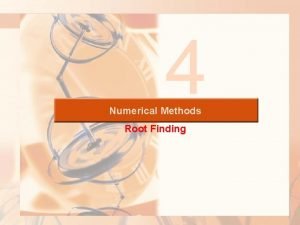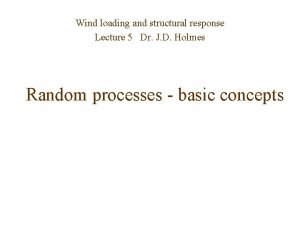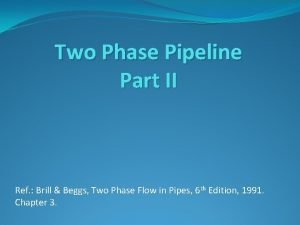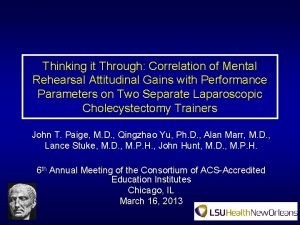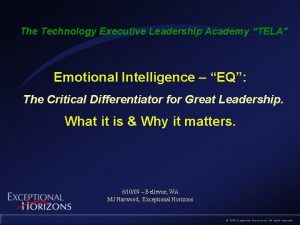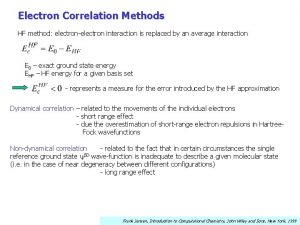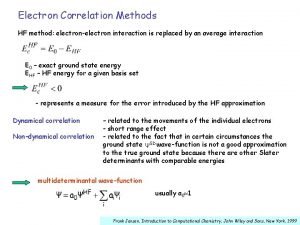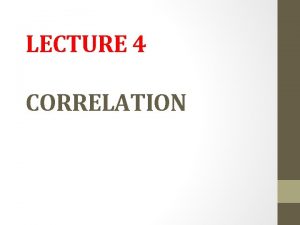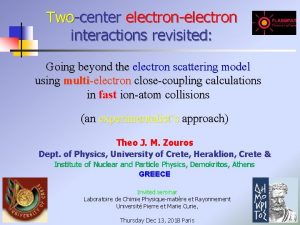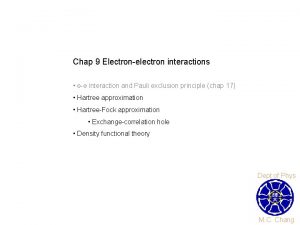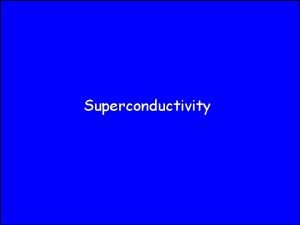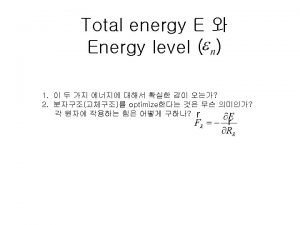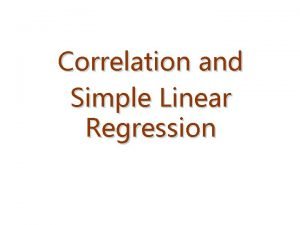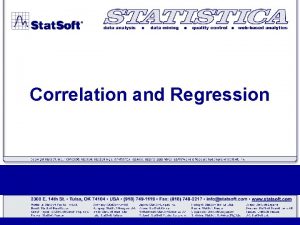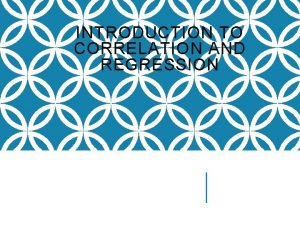Electron Correlation Methods HF method electronelectron interaction is
















- Slides: 16

Electron Correlation Methods HF method: electron-electron interaction is replaced by an average interaction E 0 – exact ground state energy EHF – HF energy for a given basis set - represents a measure for the error introduced by the HF approximation Dynamical correlation – related to the movements of the individual electrons - short range effect - due the overestimation of short-range electron repulsions in Hartree. Fock wavefunctions Non-dynamical correlation - related to the fact that in certain circumstances the single SD reference ground state wave-function is inadequate to describe a given molecular state (i. e. in the case of near degeneracy between different configurations) - long range effect Frank Jensen, Introduction to Computational Chemistry, John Wiley and Sons, New York, 1999

Correlation Energy: Is it important? N 2 molecule: CE ~ 0. 5% of the EE ~ 50% of the binding energy!

Long-range correlation wrong dissociation behavior for RHF wavefunction! Potential energy curves for H 2 molecule

multideterminantal wave-function usually a 0 1

Short-range correlation Consider the Hamiltonian for He atom: Close to r 12 = 0, the term 1/r 12 becomes infinite; however, the energy is finite. there must be an additional singularity in the Hamiltonian which cancels 1/r 12 term for r 12 ≈ 0. The only candidate for this canceling term is the kinetic energy. The RHF wavefunction overestimates the probability of finding the two electrons close together (the electrons are avoided to get too close to each other because the electrostatic interaction is treated in only an average manner), and this in turn implies an overestimate of the electron repulsion energy. This is a dynamical effect (related to the electron movements) characteristic for short range distances and the corresponding energy is called correlation energy. For electrons with parallel spins, the exchange interaction (Fermi hole) contributes significantly to the reduction of the overestimation of 1/r 12; the electrons are already kept apart by the Pauli principle, and the effects of electron correlation neglect are fairly minor.

Excited Slater Determinants (ESD) Suppose we have N electrons and K basis functions used to expand the MOs RHF formalism will give N/2 occupied MOs and K-N/2 virtual MOs ESD – obtained by replacing MOs which are occupied in the HF determinant by unoccupied MOs - singly, doubly, triply, quadruply, etc. excited relative to the HF determinant Total number of ESD depends on the size of the basis set If all the possible ESD (in a given basis set) are included then all the electron correlation energy is recovered

Methods including electron correlation are two-dimensional !! In many cases the interest is only in calculating the correlation energy associated with the valence electrons Frozen Core Approximation (FCA) = limiting the number of ESD to only those which can be generated by exciting the valence electrons - it is not justified in terms of total energy because the correlation of core electrons gives substantial contribution. However, it is essentially a constant factor which drops out when relative energies are calculated Methods for taking the electron correlation into account: Configuration Interaction (CI) Many Body Perturbation Theory (MBPT) Coupled Cluster (CC) Moller-Plesset (MP) Theory

Configuration Interaction (CI) -based on the variational principle, the trial wave-function being expressed as a linear combination of Slater determinants The expansion coefficients are determined by imposing that the energy should be a minimum. The MOs used for building the excited determinants are taken from HF calculation and held fixed In the large basis set limit, all electron correlation methods scale at least as K 5 Example Molecule: H 2 O Basis set: 6 -31 G(d) => 19 BF => 38 spin MOs (10 occupied, 28 virtual) The total number of excited determinants will be Many of them will have different spin multiplicity and can therefore be left out in the calculation. Generating only the singlet Configurational State Functions (CSF) we still obtain 1002001 determinants!!! Full CI method is only feasible for quite small systems!!!

Configuration State Functions Consider a single excitation from the RHF reference. Both RHF and (1) have Sz=0, but (1) is not an eigenfunction of S 2. RHF (1) Linear combination of singly excited determinants is an eigenfunction of S 2. Configuration State Function, CSF (Spin Adapted Configuration, SAC) Singlet CSF Only CSFs that have the same multiplicity as the HF reference

Truncated CI methods Truncating the expansion given above at level one => CIS CID CISDTQ - CI with only single excited determinants CI with only doubly excited determinants CI with Singles and Doubles (scales as K 6) CI with Singles, Doubles and Triples (scales as K 8) CI with Singles, Doubles, Triples and Quadruples (scales as K 10) gives results close to the full CI can only be applied to small molecules and small basis sets CISD - the only CI method which is generally feasible for a large variety of systems - recovers 80 -90% of the available correlation energy

Multi-Configuration Self-Consistent Field Method (MCSCF) - is the CI method in which the MOs are also varied, along with the coefficients of the CI expansion MCSCF methods - are mainly used for generating a qualitatively correct wave-function - recover the static part of the correlation (the energy lowering is due to the greater flexibility in the wave-function) dynamic correlation – the correlation of the electrons’ motions In MCSCF methods the necessary configurations must be selected CASSCF (Complete Active Space SCF) - the selection of the configurations is done by partitioning the MOs into active and inactive spaces active MOs - some of the highest occupied and some of the lowest unoccupied MOs Within the active MOs a full CI is performed A more complete notation for this kind of methods is: [n, m]-CASSCF - n electrons are distributed in all possible ways in m orbitals

9 8 Carry out Full CI and orbital optimization within a small active space. 7 Six-electron in six-orbital MCSCF is shown (written as [6, 6]CASSCF) 6 Complete Active Space Self-consistent Field (CASSCF) 5 4 3 2 1 H 2 O MOs Why? 1. To have a better description of the ground or excited state. Some molecules are not well-described by a single Slater determinant, e. g. O 3. 2. To describe bond breaking/formation; Transition States. 3. Open-shell system, especially low-spin. 4. Low lying energy level(s); mixing with the ground state produces a better description of the electronic state.

Alternative to CASSCF Restricted Active Space SCF (RASSCF) RASSCF – the active MOs are further divided into three sections: RAS 1, RAS 2 and RAS 3 RAS 1 space – MOs doubly occupied in the HF reference determinant RAS 2 space – both occupied and virtual MOs in the HF reference determinant RAS 3 space – MOs empty in the HF reference determinant Configurations in RAS 2 are generated by a full CI Additional configurations are generated by allowing for example a maximum of two electrons to be excited from RAS 1 and a maximum of two electrons to be excited to RAS 3 RASSCF combines a full CI in a small number of MOs (RAS 2) and a CISD in a larger MO space (RAS 1 and RAS 3)

MØller-Plesset Perturbation Theory - a perturbational method in which the unperturbed Hamiltonian is chosen as a sum over Fock operators The sum of Fock operators counts the average electron-electron repulsion twice and the perturbation is chosen the difference: where Vee represents the exact operator for the electron-electron repulsion It can be shown (Jensen, pag. 127) that the zero order wave-function is the HF determinant while the zero order energy is just the sum of MO energies. Also, the first order energy is exactly the HF energy so that in this approach the correlation energy is recovered starting with the second order correction (MP 2 method) In addition, the first contribution to the correlation energy involves a sum over doubly excited determinants which can be generated by promoting two electrons from occupied MOs i and j to virtual MOs a and b. The explicit formula for the second order Moller-Plesset correction is: MP 2 method - scales as K 5 - accounts for cca. 80 -90% of the correlation energy - is fairly inexpensive (from the computational resources perspective) for systems with reasonable number of basis functions (100 -200)

Coupled Cluster (CC) Methods The idea in CC methods is to include all corrections of a given type to infinite order. The wave-function is written as: where: with the cluster operator given by: Acting on the HF reference wave function, the Ti operator generates all i-th excited Slater determinants: The exponential operator may be rewritten as: First term generates the reference HF wave-function Second term generates all singly excited determinants First parentheses generates all doubly excited states (true doubly excited states by T 2 or product of singly excited states by the product T 1 T 1

The second parentheses generates all triply excited states, true (T 3) or products triples (T 1 T 2, T 1 T 1 T 1) The energy is given by: So, the coupled cluster correlation energy is determined completely by the singles and doubles amplitudes and the two-electron MO integrals Truncated Coupled Cluster Methods If all TN operators are included in T the CC wave-function is equivalent to full CI wavefunction, but this is possible only for the smallest systems. Truncation of T Including only the T 1 operator there will be no improvement over HF, the lowest level of approximation being T=T 2 ( CCD=Coupled Cluster Doubles) If T=T 1+T 2 CCSD If T=T 1+T 2+T 3 CCSDT scales as K 6 scales as K 8 the only generally applicable model
 Positive correlation versus negative correlation
Positive correlation versus negative correlation No correlation gif
No correlation gif Types of correlation
Types of correlation Correlation analysis deals with
Correlation analysis deals with Actual mean method of correlation
Actual mean method of correlation Karl pearson coefficient of correlation example
Karl pearson coefficient of correlation example Inlay wax pattern fabrication
Inlay wax pattern fabrication Symposium is a type of
Symposium is a type of The role of teacher in direct method
The role of teacher in direct method Secant method solved examples
Secant method solved examples Fixed point iteration method
Fixed point iteration method Load response correlation
Load response correlation Rs tabel spearman
Rs tabel spearman Beggs and brill method
Beggs and brill method P value pearson correlation
P value pearson correlation Eq and iq correlation
Eq and iq correlation Example of positive correlation in psychology
Example of positive correlation in psychology




